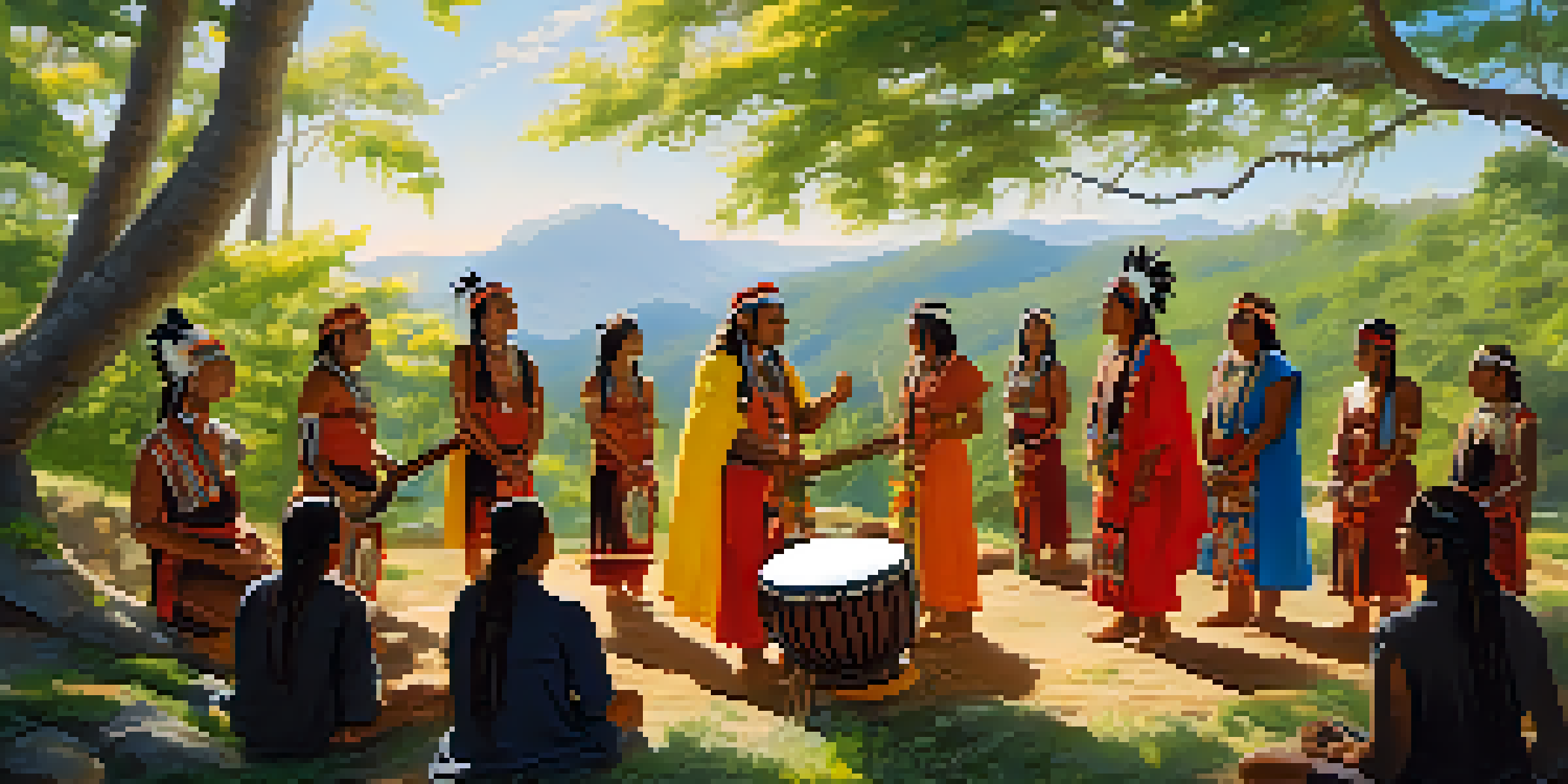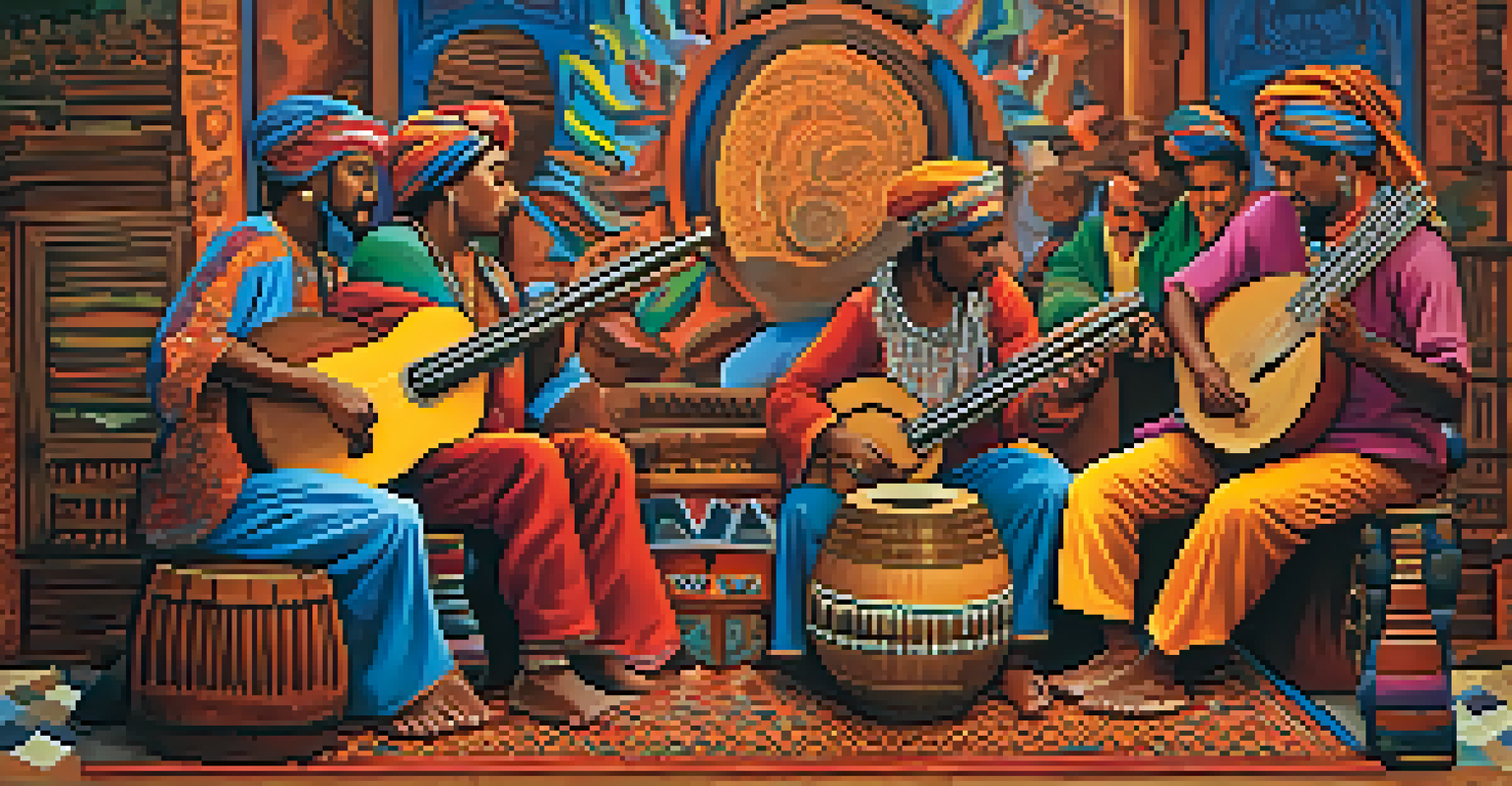Cultural Rhythms: Entheogens' Impact on World Music

Understanding Entheogens and Their Role in Culture
Entheogens are substances that, when consumed, can facilitate altered states of consciousness. They have been used in various cultures for centuries, often in spiritual and religious contexts. The relationship between these substances and music is profound, as both serve to connect individuals to something greater than themselves.
Music can change the world because it can change people.
In many indigenous cultures, music and entheogens intertwine, creating a shared experience during rituals. For example, the use of peyote in Native American ceremonies often incorporates drumming and chanting, elevating the communal experience. These practices highlight how music can enhance the effects of entheogens, creating a deeper emotional resonance.
As we explore the role of entheogens in world music, it's important to recognize their cultural significance. They are not merely tools for escapism but are deeply rooted in the traditions that celebrate life, death, and everything in between.
The Connection Between Music and Altered States
Music has a unique ability to alter our emotional and psychological states, which parallels the effects of entheogens. When combined, these elements can create transformative experiences, often described as transcendent or enlightening. Just as a powerful melody can evoke deep feelings, so too can entheogens amplify these emotional responses.

Consider the use of sound in shamanic practices, where rhythmic drumming leads participants into trance states. This synergy between music and altered consciousness is not just a coincidence; it’s a deliberate method of accessing deeper realms of the psyche. The result is a rich tapestry of sound that enhances the journey inward.
Entheogens Enhance Musical Rituals
Many cultures incorporate entheogens into musical rituals, creating profound communal experiences that connect participants spiritually.
This connection helps explain why many cultures view music as a sacred tool in their spiritual practices. By integrating sound and entheogens, individuals can explore the depths of their existence and connect with the universe on a profound level.
Entheogens in Traditional African Music
In many African cultures, music plays a pivotal role in spiritual ceremonies, often accompanied by the use of entheogens. For instance, the use of iboga in Bwiti rituals brings participants together through music, dance, and the collective experience of altered consciousness. The rhythms and melodies of traditional African music foster a sense of unity and connection among participants.
The use of psychedelics can lead to insights that are similar to the insights of spiritual practices.
Moreover, these musical traditions are not just for entertainment; they serve as a medium for storytelling and cultural transmission. The use of entheogens during these ceremonies often enhances the storytelling aspect, allowing participants to experience the narratives on a deeper level. This integration of music and substance creates a holistic approach to spirituality and communal identity.
The impact of these practices can be seen beyond Africa, influencing various music genres worldwide. As African rhythms blend with modern interpretations, the echoes of these traditional practices continue to resonate in contemporary music.
Entheogens and Indigenous Music in the Americas
Across the Americas, Indigenous peoples have long used entheogens in their music and rituals. For example, the Native American Church incorporates peyote in their ceremonies, where music plays an essential role in guiding participants through their experiences. The songs sung during these rituals are often considered sacred, acting as a bridge between the physical and spiritual realms.
In South America, the Amazonian tribes utilize ayahuasca in their spiritual practices, accompanied by traditional music that enhances the experience. The chants and melodies serve not only to facilitate the journey but also to invoke protective spirits and ancestors. This profound connection between music and the entheogenic experience highlights the importance of preserving these traditions.
Music Amplifies Altered States
The synergy between music and entheogens can lead to transformative experiences, allowing individuals to explore deeper emotional and psychological realms.
As globalization continues to influence music, the sounds of Indigenous cultures are being embraced and reinterpreted. This revitalization can bring awareness to the spiritual practices surrounding entheogens, helping to preserve these vital cultural expressions.
The Psychedelic Music Movement of the 1960s
The 1960s marked a significant cultural shift, where entheogens became intertwined with the burgeoning music scene. Artists like The Beatles and Jefferson Airplane embraced psychedelic experiences, both in their personal lives and their music. This era saw the emergence of a new genre that celebrated the exploration of consciousness through sound and substance.
Psychedelic rock utilized innovative techniques, such as the use of reverb and distortion, to create a soundscape that mirrored the experience of altered states. The music itself became a conduit for exploring deeper realities, inviting listeners to join in the journey. Concerts and festivals became communal spaces where the mind-expanding effects of music and entheogens converged.
Today, the legacy of the psychedelic music movement continues to influence contemporary artists. The melding of music and entheogenic experiences remains a powerful tool for self-exploration and collective expression, echoing the traditions of the past.
Globalization and the Fusion of Musical Styles
As cultures intermingle in our increasingly globalized world, the fusion of musical styles is becoming more prevalent. This blending often incorporates elements of entheogenic practices, creating new genres that resonate with diverse audiences. For instance, electronic music has embraced indigenous sounds and themes, using them to enhance the listener's experience.
Artists are experimenting with incorporating traditional rhythms and instruments from various cultures, creating a rich tapestry of sound that reflects a global consciousness. This musical fusion not only celebrates cultural diversity but also highlights the universal themes of spirituality and connection that entheogens inspire.
Global Fusion of Music and Culture
As globalization progresses, the blending of musical styles often integrates entheogenic practices, reflecting a universal connection to spirituality.
By embracing these global influences, musicians can introduce listeners to the profound ways in which music and entheogens can shape experiences and perceptions. As this trend continues, it paves the way for deeper dialogues around the importance of cultural heritage and the role of spirituality in music.
The Future of Music and Entheogens
Looking ahead, the relationship between music and entheogens is likely to evolve further. As society becomes more open to exploring altered states of consciousness, we may see a resurgence of interest in the spiritual and therapeutic aspects of these substances. This shift could lead to new musical expressions that draw inspiration from ancient practices while incorporating modern techniques.
Moreover, as scientific research continues to unveil the benefits of entheogens in mental health, musicians may find themselves at the forefront of this movement. Collaborations between artists and researchers could foster innovative projects that explore the healing potential of music and psychedelics, creating immersive experiences that resonate on multiple levels.

Ultimately, the future of music and entheogens is about connection—connecting with ourselves, each other, and the world around us. As we navigate this journey, the rhythms of our cultures will continue to intertwine, creating a harmonious blend that celebrates the human experience.